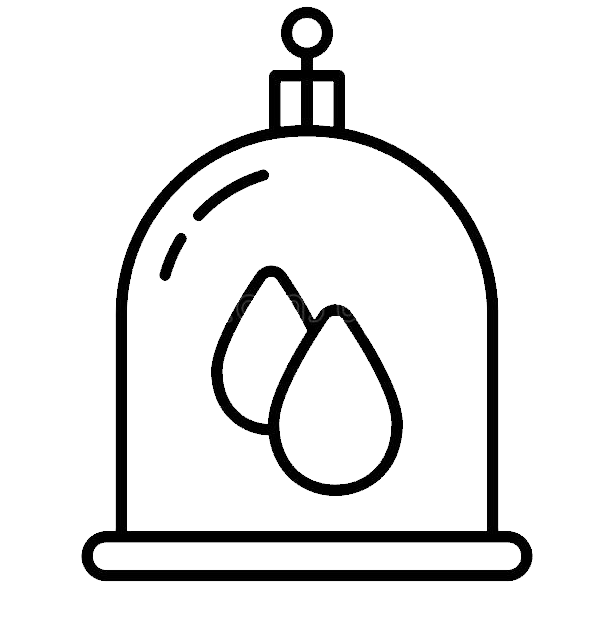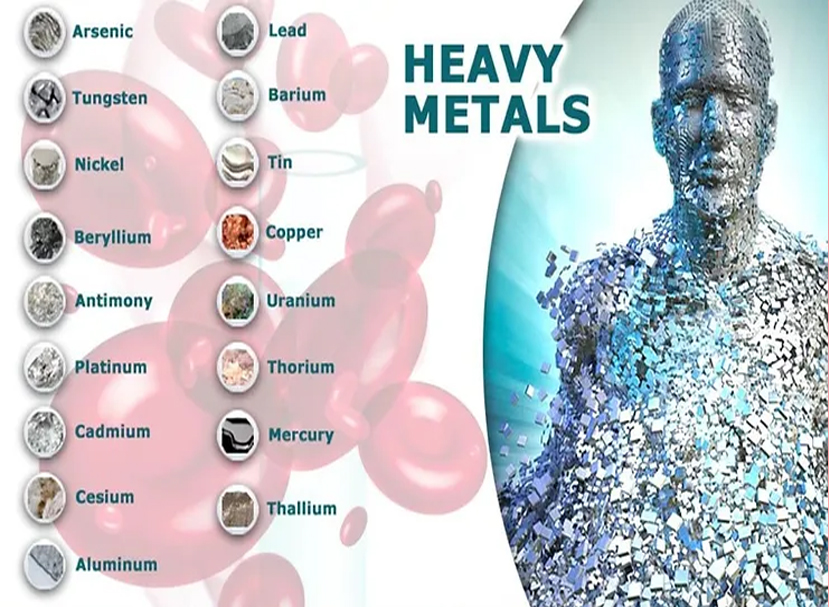

Mehdipatnam, Hyderabad, Telangana
9 am to 6 pm (Fridays off)
Heavy metals, such as lead, mercury, arsenic, cadmium, and others, are toxic substances that can have extremely harmful effects on the body. Heavy metals can adversely affect human health :
- Organ Damage: Heavy metals can target specific organs and cause damage. For example, lead primarily affects the central nervous system and can lead to developmental delays in children and neurological issues in adults. Mercury can damage the kidneys and nervous system, while cadmium can harm the kidneys and lungs.

- Toxicity: Heavy metals can interfere with normal cellular functions and disrupt biological processes. Heavy metals have the potential to accumulate in tissues and organs, leading to long-term damage.
- Neurological Effects: Many heavy metals have neurotoxic properties, meaning they can damage the nervous system. They can impair cognitive function, cause neurological disorders, and lead to symptoms such as memory loss, difficulty concentrating, nerve damage, and behavioral changes.
- Carcinogenic Effects: Some heavy metals, such as arsenic, cadmium, and certain forms of chromium, have been classified as carcinogens. Prolonged exposure to these substances increases the risk of developing various types of cancers, including lung, bladder, and liver cancer.
- Cardiovascular Effects: Heavy metals like lead and cadmium have been associated with cardiovascular problems. They can contribute to high blood pressure, heart disease, and an increased risk of heart attacks and strokes.
- Reproductive and Developmental Issues: Heavy metals can have adverse effects on reproductive health and fetal development. They can disrupt hormonal balance, impair fertility, and lead to complications during pregnancy. Some heavy metals, such as lead and mercury, can be passed from mother to child, potentially causing developmental disorders.
- Kidney Damage: Several heavy metals, including lead, mercury, and cadmium, can accumulate in the kidneys and cause kidney damage or dysfunction. This can result in impaired filtration and elimination of waste products from the body.
It's important to note that the specific health effects of heavy metals depend on the type of metal, dose, duration of exposure, and individual susceptibility. Occupational exposure, environmental pollution, contaminated food or water, and certain consumer products are common sources of heavy metal exposure.
The body has natural mechanisms to eliminate toxins, including heavy metals, but there are several reasons why it may not be able to expel them efficiently:
1. Absorption and Accumulation: Heavy metals can enter the body through various sources such as contaminated air, water, food, or exposure to certain occupational or environmental conditions. Once inside the body, these metals can be absorbed and accumulate in various tissues, including the liver, kidneys, bones, and brain. The accumulation of heavy metals over time can overwhelm the body's natural detoxification processes.
2. Complex Metabolism: Some heavy metals, such as lead, mercury, arsenic, and cadmium, have complex metabolic pathways in the body. They can undergo transformations and become tightly bound to tissues, making them less accessible for elimination. These metals can also be stored in body compartments, like bones, where they can remain for extended periods, further impeding their elimination.
3. Low Elimination Rate: Heavy metals can have a slow elimination rate from the body. The process of detoxification and elimination relies on specific enzymes, transporters, and excretory systems. In some cases, the body's natural mechanisms for eliminating heavy metals may not be efficient enough to eliminate them rapidly, resulting in their persistence.
4. Binding to Body Proteins: Heavy metals can bind to proteins in the body, altering their structure and function. This can disrupt normal cellular processes and interfere with the body's ability to identify and eliminate these metals effectively.
5. Overburdened Detoxification Pathways: The body's detoxification pathways, primarily involving the liver and kidneys, may become overwhelmed when exposed to high levels of heavy metals or when other toxic substances are present. When these pathways are overloaded, the elimination of heavy metals can be impaired.
6. Genetic Factors: Genetic variations can influence an individual's ability to eliminate heavy metals. Some people may have genetic variations that affect the function of enzymes involved in detoxification pathways, making them more susceptible to heavy metal toxicity and impairing their elimination.
It's important to note that the body does have natural defense mechanisms to eliminate heavy metals, and in most cases, it can successfully eliminate small amounts. However, chronic or high-level exposure to heavy metals can overwhelm these mechanisms and result in accumulation and toxicity. In such cases, Hijama Cupping can greatly help to enhance the elimination of heavy metals from the body.
The following are some ways in which hijama potentially supports in the removal of heavy metals:
1. Increased Blood Circulation: Hijama involves creating suction on specific points of the body using cups, which enhances blood circulation in the treated areas. Improved blood circulation helps mobilize heavy metals from tissues and facilitate their transportation to elimination organs like the liver and kidneys.
2. Lymphatic System Stimulation: Hijama stimulates the lymphatic system, which plays a crucial role in waste removal from the body. The suction applied during hijama assists in promoting lymphatic flow, potentially aiding in the elimination of heavy metals and other toxins through the lymphatic system.
3. Detoxification Support: Hijama assists in the detoxification process by drawing out impurities from the underlying tissues. The suction created during hijama helps remove heavy metals that have accumulated in tissues, assisting the body's natural detoxification mechanisms.
There is ample reference to Hijama being a means by which the body’s toxic blood is removed, and for the average John Doe, proof of it is generally shown through the coagulation of the removed blood in the cup and its characteristic dark colour. The argument could be posed that all blood clots when exposed to air, thus making the example that its clotting is indicative of its toxicity a moot point. However, studies go beyond that and prove that the blood content of Hijama is starkly different to that of venous blood, say that which is taken out in a blood test for example.
In a study conducted by the Turgut Ozal University (Gok, et al. 2016), it was proved that the percentage of heavy metals (such as mercury, lead and aluminium) extracted by Hijama was at least 2-8 times higher than in normal venous blood content. In the modern-day industrial world, human exposure to heavy metals has exponentially grown and can be found in contaminated food and drinking water, as well as other pathways such as in creams and dermal care products. It is well known that heavy metal toxicity can prove disastrous to one’s health and severely affect the intellectual ability and cause nervous system disorders, lung damage etc. Long-term exposure to certain heavy metals can also progressively lead to cancer, Parkinson’s disease, multiple sclerosis and muscular dystrophy (Engwa, et al. 2019). Hijama has been scientifically proven to be a convenient and safe mode of extraction of the aforesaid heavy metals from our blood, and there is no other tested treatment modality that can purify both blood and interstitial fluids from toxic metals.
In another study conducted and supervised by Dr. M. Nabeel Al-Shareef (Sheikho 2012), it was shown that Hijama led to a decrease in the value of uric acid, creatinine, cholesterol and the liver enzyme SGPT in the blood in cases where it was high. It was also shown that there was a rise in leukocytes, thrombocytes, haemoglobin and neutrophils up to the normal limit in cases where it was low. This illustrates the regulating capacity of the Hijama procedure for the body’s blood, both by removing unwanted elements and creating an environment that’s conducive to the production of new and healthy blood, something that isn’t possible by simply removing venous blood through injection or the like.
Our body is a constant recipient of years of toxic build-up in our blood whether through our food intake, the water we drink, the products we apply or the atmosphere we are exposed to. Such toxins and heavy metals cannot be cleaned by the liver and kidneys alone; this is where Hijama comes in. The intradermal incisions applied in the procedure make sure that healthy blood is not targeted and only the toxicities floating on the superficial areas of our circulatory system are brought out. In addition to this, Hijama is also a means by which a healthy environment is created through blood cleansing -resulting in healthy cell production- instead of spiralling an already diseased state by duplicating diseased blood cells. The enormous benefits of Hijama both as a treatment modality and preventative medicine cannot be ignored, as the focal point of the onset of any disease is almost always the inadequacy of the blood.

Writer
Imran Khan
Lead Practitioner at i-ReviveOne of the most commonly disregarded fact is that blood circulation issues can indirectly cause hormonal imbalances . Let's say when someone is diagnosed with Hypothyroid it not necessarily mean that the Thyroid gland...
Read MoreBlood cleansing plays a vital role in maintaining good health and overall well-being. The bloodstream acts as a transportation network, delivering essential nutrients, oxygen, and hormones to cells throughout the body and...
Read MoreThe proper functioning of our organs and muscles relies on a continuous and ample blood supply, which carries vital resources such as oxygen, nutrients, healing agents, hormones, anti-inflammatories, and natural pain relievers like opi...
Read MoreWhen cups are applied to the skin, a negative pressure is created, causing a rapid diffusion of various substances within the tissues. These substances are drawn...
Read MoreHijama, also known as cupping therapy, is considered a divine therapy that encompasses the body, mind, and soul. The human body relies on five vital organs—heart, brain, kidneys, liver, and lungs—for survival. The de...
Read MoreHijama Cupping therapy extends beyond the mere placement of cups, incisions, and blood extraction. The utilization of negative pressure and superficial incisions during Hijama Cupping yields diverse and profound effe...
Read MoreSpider veins are often confused with varicose veins, but there are distinct differences between the two. Spider veins are smaller, closer to the skin's surface, and typically do not cause significant symptoms. Varicose veins, on these a...
Read MorePolycystic ovary syndrome (PCOS) is a hormonal disorder affecting many women worldwide. It is characterized by hormonal imbalances, ovarian cysts, and various symptoms such as irregular menstrual cycles, excessive hair...
Read MoreHeavy metals, such as lead, mercury, arsenic, cadmium, and others, are toxic substances that can have extremely harmful effects on the body. Heavy metals can adversely affect human health: - Toxicity: Heavy metals ...
Read More